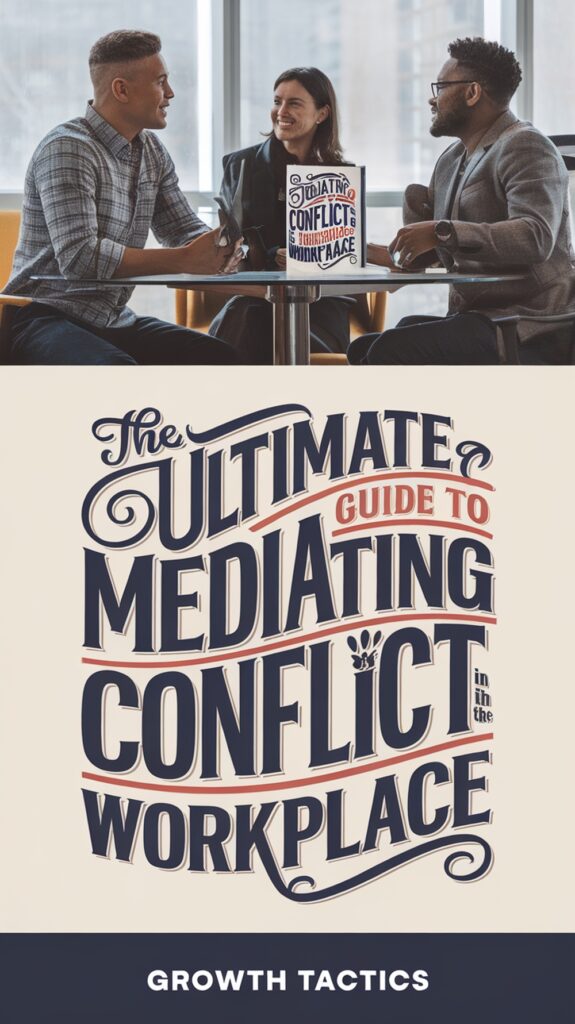Picture this: You walk into your workplace, and the air feels light.
Smiles greet you at every turn. Coworkers chat easily, sharing ideas and solving problems together. There’s no tension, no awkward silences, no passive-aggressive emails.
This isn’t a fairy tale.
It’s what a conflict-free work center looks like. And guess what? You can help create this reality.
In this guide on mediating conflict in the workplace, you’ll learn to tackle workplace conflicts head-on, with confidence and skill.
Ready to make a real difference? Let’s get started!
Jump To Section
Understanding Workplace Conflict
Conflict at work is normal. I’ve seen it happen in every office I’ve worked in. But understanding it can help you solve it.
What Causes Workplace Conflict?
Conflicts often start small. Maybe someone feels left out of a decision. Or two people have different ideas about how to do a job. Sometimes, it’s just a misunderstanding.
I’ve found that most conflicts have common causes:
- Poor communication
- Different values or goals
- Unclear job roles
- Stress and pressure
- Personality clashes
It’s important to remember that everyone sees things differently. What bothers one person might not bother another.
Signs of Conflict in the Workplace
Spotting conflict early can save a lot of headaches.
Here are some signs I look for:
- People avoid each other
- There’s a lot of gossip
- Work quality drops
- Team members stop cooperating
- Meetings get tense
Trust your gut. If something feels off, it probably is.
Why Addressing Conflict Matters
You might think it’s easier to ignore conflicts. But that never works out well. I’ve seen small issues turn into big problems when left alone.
Dealing with conflicts can:
- Improve teamwork
- Boost morale
- Increase productivity
- Create a better work environment
Remember, every conflict is a chance to make things better.
Key Skills for Effective Mediation
I’ve learned that certain skills are essential for effective mediation. Let’s explore the key abilities that’ll help you be a great mediator.
Active Listening
This is the foundation of good mediation. I always start by really listening to each person involved.
Here’s what I do:
- Pay full attention
- Don’t interrupt
- Show I’m listening with nods and eye contact
- Ask questions to understand better
A lot of times, people just want to be heard. When you listen well, you’re already halfway to solving the problem.
Staying Neutral
As a mediator, you’re not picking sides. I know it can be tough, but you need to stay neutral.
Here’s how I do it:
- Treat everyone equally
- Don’t judge
- Keep my personal opinions out of it
- Focus on facts, not emotions
Your job is to guide the conversation, not to decide who’s right or wrong.
Clear Communication
You need to be a bridge between the people in conflict.
I always try to:
- Speak clearly and simply
- Avoid taking sides
- Summarize what each person says
- Check that everyone understands
Good communication can turn a heated argument into a productive discussion.
Emotional Intelligence
Conflicts are full of feelings. To handle them well, you need to:
- Recognize emotions in yourself and others
- Stay calm, even when others aren’t
- Show empathy
- Help others name and understand their feelings
I’ve found that addressing emotions often leads to solving the actual problem.
Problem-Solving Creativity
Sometimes, the solution isn’t obvious. That’s when you need to get creative.
I like to:
- Encourage brainstorming
- Look for win-win solutions
- Think outside the box
- Help others see new perspectives
Remember, the best solution often comes from the people in conflict themselves.
These skills take practice, but don’t worry. You’ll get better with each conflict you help resolve. In the next section, we’ll look at how to put these skills into action with a step-by-step mediation process.
Step-by-Step Conflict Resolution Process
I’ve found that following a clear process makes conflict resolution much easier.
Let’s walk through the steps together.
Step 1: Set the Stage
First, you need to create the right environment.
Here’s what I do:
- Find a quiet, private place to talk
- Make sure everyone feels comfortable
- Explain the process and set some ground rules
- Remind everyone that we’re here to find a solution, not to blame
Remember, your goal is to make everyone feel safe and heard.
Sample Ground Rules for Workplace Mediation:
Here are some sample ground rules I like to use:
- Respect each other’s time to speak. No interrupting.
- Use “I” statements. Say “I feel” instead of “You always.”
- Stay calm. If you need a break, just ask.
- Be honest, but kind. We’re all here to solve a problem.
- Keep what’s said here private. Don’t share outside this room.
- Focus on the future. We can’t change the past, but we can make tomorrow better.
- Listen to understand, not to argue. Try to see things from the other person’s view.
- Work together to find answers. The best solutions come from teamwork.
I’ve found these rules help keep things fair and productive.
But remember, you know your team best. Feel free to adjust these to fit your needs. The key is making sure everyone agrees to follow them.
Step 2: Gather Information on the Disagreement
Now it’s time to understand what’s really going on.
I always:
- Ask each person to share their side of the story
- Listen carefully without interrupting
- Take notes on key points
- Ask questions to clarify anything I’m unsure about
Don’t rush this step. The more you understand, the better you can help.
Sample Questions for Dispute Resolution:
I’ve found these questions helpful in getting to the heart of the matter:
- “Can you tell me what happened from your point of view?”
- “How did this situation make you feel?”
- “What do you think caused this problem?”
- “Have you tried to solve this before? What happened?”
- “What would a good solution look like to you?”
- “How has this affected your work or relationships here?”
- “What do you need to feel better about this situation?”
- “Is there anything else you think I should know?”
Remember, these are just starting points. I always listen closely and ask follow-up questions based on what I hear.
Your goal is to really understand each person’s perspective. Don’t be afraid to dig deeper if something’s not clear.
Step 3: Identify the Real Problem
Often, what people are arguing about isn’t the real issue.
I try to:
- Look for common themes in what everyone’s saying
- Ask about feelings and needs, not just actions
- Summarize what I think the core problem is
- Check if everyone agrees with my summary
This step can be eye-opening for everyone involved.
Step 4: Brainstorm Solutions to Resolve Conflict
Now comes the fun part, finding solutions!
I encourage everyone to:
- Suggest as many ideas as possible
- Don’t judge ideas at this stage
- Think creatively
- Build on each other’s suggestions
Remember, the best solution often comes from the group, not from you.
Sample Brainstorming Exercise: The Idea Dump
Here’s an exercise I love to use. I call it the “Idea Dump.” It’s simple but powerful:
- Give everyone a stack of sticky notes and a pen.
- Set a timer for 5 minutes.
- Ask everyone to write down as many ideas as they can. One idea per sticky note.
- When time’s up, have each person stick their notes on a wall or board.
- Group similar ideas together.
- Give everyone three dot stickers.
- Let the group vote on their favorite ideas by placing their stickers.
I’ve seen this work wonders. It gets everyone involved and often leads to surprising solutions.
Remember, your job is to guide, not to solve. Trust the process and the people. You’ll be amazed at what your team can come up with when given the chance.
Step 5: Evaluate and Choose a Solution
It’s time to pick the best way forward.
Here’s how I guide this:
- Review all the ideas
- Discuss the pros and cons of each
- Help the group find a solution everyone can live with
- Make sure the solution is specific and doable
The key is finding a win-win solution that works for everyone.
Step 6: Create an Action Plan
A solution is only good if it’s put into action. I always:
- Write down the agreed solution
- Decide who will do what and when
- Set a time to check in and see how it’s going
- Make sure everyone understands and agrees to the plan
This step turns good intentions into real change.
Sample Action Plan Template: The Road Map
I like to use what I call “The Road Map” template. It’s simple but effective. Here’s how it looks:
- Our Goal: [Write the agreed solution here]
- Action Steps:
- Step 1: [What needs to be done]
Who: [Person responsible]
When: [Deadline] - Step 2: [What needs to be done]
Who: [Person responsible]
When: [Deadline]
- Step 1: [What needs to be done]
- Check-in Date: [Set a date to review progress]
- How We’ll Measure Success: [List 2-3 ways you’ll know if the plan is working]
- Team Agreement: [Have everyone sign or initial to show they’re on board]
I’ve found this template works well for most situations. It’s clear and keeps everyone on the same page.
Remember, every conflict is unique. You might need to adjust these steps to fit your situation. The most important thing is to keep an open mind and stay focused on finding a solution. You’ve got this!
Wrapping Up: Your Path to Workplace Harmony
I’ve shared a lot with you about mediating conflict in the workplace. Now it’s your turn to put these ideas into action.
Remember, every workplace is different, and so is every conflict. You’ll need to find your own way to use these tools. Trust yourself and your team to come up with solutions that work for you.
Your workplace can be a place where people work well together and enjoy what they do. It starts with you. Go out there and create the positive change you want to see!


